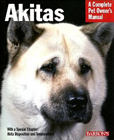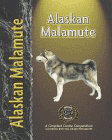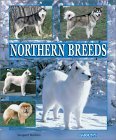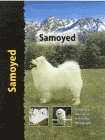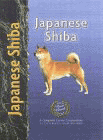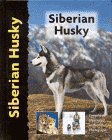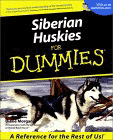Books on Animals: Dogs
Dog Breeds: Spitz Dogs
(Akitas, Alaskan Malamutes, Chows, Elkhounds, Keeshonds, Samoyeds, Shiba Inu and Siberian Huskies).
If you want to buy a book, clicking on the book cover will take you directly to that book on the Amazon.co.uk web site.
See also:
- Dogs in recent history and different cultures
- Books on origins, canine evolution and wolves
- Behaviour (canine ethology and behavioural problems)
- Puppy and manners training
- Breeding, grooming and kennel management
- Fiction dealing with dogs
- Skill training: Agility and training games
- Skill training: Sheepdog, gundog and scent work
General overview
Spitz breeds have many fans. They are good-looking dogs, with small, erect ears, tails carried over their backs, and most bear a distinct resemblance to wolves. They include the northern breeds, Alaskan Malamutes, Norwegian Elkhounds, Keeshonds, Samoyeds and Siberian Huskies, and the Asian breeds, Akitas, Chow Chows and Shiba Inu. The northern breeds tend to be gregarious, both with humans and with other dogs, while the two larger Asian breeds tend to be more aloof with humans other than their owners, and are more prone to dog aggression. The northern breeds and Shiba Inu are generally very tolerant of children, so long as the children are sensible. These dogs shouldn't be taken for granted, however, and small children and dogs always need supervision. The two larger Asian spitz breeds need much more supervision with children, and it is worth thinking long and hard before combining the two. It's not so much that they would harm a child of the family, more that it is difficult to supervise children and dogs when children's playmates come round. Though well-socialized northern spitz dogs and Shiba Inu usually get on well with other dogs, they are still capable of getting into scraps, while some Akitas and Chow Chows can learn to tolerate other dogs, if enough care is taken with their socialization.
All the spitz breeds have some behavioural characteristics in common, notably independence and intelligence. They tend to learn fast, and get bored easily, so they need owners who are prepared to keep them on their toes and interested in training. They won't carry on performing the same task in the way a more obedient or obsessive breed (like a Border Collie) might, rather they will simply stop cooperating, or decide to do something else more amusing, if they are asked to do the same obedience exercise too often. They are often described as bright, but stubborn. Clumsy efforts to 'show them you are the alpha' tend to be met with amusement, boredom or hostility. Spitz breeds do benefit from long-term training, however, they just want you to make it interesting. Training should begin while they are pups, and firm house rules should be laid down for pups, since it's easier to teach them rules while they are little. These are generally headstrong dogs, so consistency about rules you want them to follow as adults is important right from the start. Some of these breeds also become big, powerful dogs, and can be very difficult to manage if they are not well trained as pups. Alaskan Malamutes and Akitas are large breed dogs, and especially powerful as adults.
{slider Read more}
Spitz dogs all need something to do or they tend to develop behavioural problems, like wrecking the house, and, especially in the case of Alaskan Malamutes and Siberian huskies, digging up the garden. Digging seems to be inbuilt with the northern breeds, both digging holes for fun, and to lie in. You can allow them to use the spot they have selected, and just give up putting plants there, or encourage them to use a particular spot, by burying treats in their own sandpit.
The northern breeds can be trained as sled dogs. Elkhounds have been used in a wide range of activities, including herding, while Keeshonds and Samoyeds can be very good agility dogs. All spitz dogs like to accompany their owners on long walks, though you need more care of where you walk with an Akita or a Chow, since they can be dog-aggressive, which makes them difficult to handle if you walk them where there are a lot of dogs. Keeshonds and Elkhounds are the most reliable off leash. Alaskan Malamutes and Siberian huskies have especially strong prey drives, and can take after cats. These two breeds also tend to have poor recall, and love running. They were bred to be sled dogs, not to do obedience exercises, so are best suited to this, if you can work them.
Sled dogs need much more food than normal while they are working, and you need to study canine nutrition to get the proportions right, since it is not just a case of boosting amounts of food. The larger breeds, Akitas and Alaskan Malamutes, also need especially careful attention to food and exercise levels while they are growing, so that their bones develop properly, and they should be fed at least twice daily as adults, to avoid bloat. Many sled dogs have a tendency to put on weight when they are not working, so their intake should be watched. Free feeding is not usually a good idea, and it helps to make food boring, avoiding high-fat treats.
Some of these breeds make good watch dogs, especially Keeshonds and Samoyeds, which are extremely vocal. The northern breeds are generally friendly, but will tend to deter intruders by giving a warning bark. Akitas and Chows can be very intimidating for someone who enters your home without your permission. It is best to socialize these Asian spitz breeds as much as possible to be safe with humans, since otherwise they may bite someone you would rather they didn't, like a neighbour's child.
Spitz dogs are generally clean, don't smell much of 'dog' and even the long coated breeds like Keeshonds and Samoyeds don't need much grooming for long-haired dogs, except when they shed their undercoats, or 'blow' their coats. Then they need grooming more than once a day, and even then will fill your house with fluff. The thickness of the coat depends very much where you live, how cold your house is, and how much time the dog spends outside. The summer coat is thinner than the winter coat, and dogs that don't get out much and live in homes with central heating, or who live in warmer areas, tend to have thinner coats. The northern breeds tend to act like puppies with the first snowfall, They love rolling in snow. They also like to roll out of doors when they are shedding, as it seems to loosen the underfur. All these breeds except chows blow their coats. Chows don't fill your house with fluff twice a year, but they do need more grooming than the other breeds.
These are thick-coated breeds, so they can all suffer in hot weather if they are not given access to shade. Especial care should be taken if they are left in cars, so that they aren't trapped in the heat. They need access to water and shade, and many like to bathe in shallow water when it is hot. They should not be taken out in the heat of the day, and strenuous exercise should be reserved for early morning and after sunset. They do like to cool their tums by lying on stone or ceramic tile surfaces in the summer, and Keeshonds especially like to lie in doorways at night.
The northern breeds like to be with their human packs, though they can tolerate being outside in winter better than humans can, and take particular pleasure in playing in snow and on frosty ground. You may want to give them access to your garden through a dog door. They do need high fences, and these fences should go underground, since these breeds can be good diggers, especially Alaskan Malamutes and Siberian huskies. They are also good at jumping, and can jump higher than you might expect for their height. They like to climb onto low walls and other raised areas to keep an eye on the world, so make sure this does not give them access to your boundary wall. It is possible for these dogs to feel the cold, even though they have thick coats, because the coat thickness depends on what they are used to. A northern breed used to central heating should not suddenly be left in an outdoor kennel in winter, for example, but needs time to adapt to cold and grow a thick coat.
Spitz dogs tend to be healthy as a group, though the larger breeds are vulnerable to bloat and problems with bone growth, as are most large-breed dogs. They need at least two meals a day and rest before and after eating, to avoid bloat, and pups need attention for their nutrition and exercise, so their bones grow properly. The Chow Chow also has particular problems, but on the whole, individuals from these breeds don't cost as much in vet bills as many breeds.
All of these dogs can be a handful if not trained properly, and they are less forgiving of mistakes than, say, Labrador or Golden Retrievers. However, Keeshonds and Elkhounds are generally the easiest to train, while Akitas and Chows are the most difficult breeds, and are not recommended for novices.
Good manners are best taught from puppyhood, because it's easier, but adult rescue dogs can still learn fast. The best time to teach good manners to a rescue dog is as soon as the dog arrives. That is when the dog is watching you to learn what the rules are. It's tempting to spoil the dog a bit, because you feel sorry for him or her. But it's kinder in the long run to let the dog know gently and firmly what you consider to be appropriate behaviour. Rescue centres usually have their own behaviourists and provide ongoing help for adopters. Gwen Bailey's 'The Rescue Dog' is also full of good advice.
{/sliders}

Akitas: The Complete Pet Owner's Manual
Akitas, also known as Japanese Akitas, are magnificent dogs, a little bigger than German Shepherds, very powerful looking, with short, thick fur and curled, upright tails. They are bold and strong-willed dogs, and are best suited to owners with experience of dogs and knowledge of training, preferably with experience of spitz dogs or other independent breeds, rather than just labradors and golden retrievers!
Akitas need to have house rules laid down from when they are pups, or they can become pushy. Resource guarding can be a problem unless these dogs are carefully trained. Akitas can learn fast, but are easily bored by repetition in training. They like company and being given interesting things to do. Akitas left at home all day and given little to do when owners are home are likely to become difficult to handle. The breed was initially developed to fight other dogs and work as a guard dog, though they are used in a range of activities today, as police dogs, guard dogs, and even service dogs, helping disabled people. They swim well, and can be good retrievers, if trained when they are young. There are two main types, the Japanese lines, which tend to be smaller, and US Akitas. Both types of Akita need careful training, and are best kept active, and allowed to be part of the family.
Akitas can be aloof with strangers while bonding strongly with their owners. They usually get on well with children in the household, though need supervision, and cannot always be trusted with visiting children. They are not suitable for households where neighbourhood children are often running in and out of the house and garden, though well socialized Akitas will accept sensible visiting children who respect them, and who have been introduced by their owners. Akita puppies need careful socialisation, both with other dogs and with humans. Akitas may still become dog aggressive as they get older, despite socialization. It is safer to exercise them on a lead, because they can't always be trusted with other dogs. They need a large garden with a high fence, since they are good at jumping, and not everyone can walk an Akita, so there may be days when they have to get their exercise in the garden. The fence should be mostly solid so that they do not have to see other dogs or small children trying to tease them - and teasing an Akita is not a sensible thing to do! Tying up an Akita with no fence is asking for trouble, since children could easily approach the dog and get hurt. Akitas are natural guard dogs, and should not be taught to distrust strangers. It's safer to lock gates to ensure that no strangers can get unsupervised access to the garden, even if your Akita is well-socialised.
Some owners take pride in owning a 'tough' dog, and there are even a few breeders who prize aggression against other dogs or humans. It is unwise to take on a dog from such a breeder, since even a relatively placid Akita is a lot to take on. It's much safer to choose a pup which has two parents of nice temperaments, and which has already been socialized to be friendly with children.
Akitas don't shed much, except when they 'blow' their coats, when they need a lot of grooming. They can be quite vocal, making a range of sounds, which owners learn to interpret. They are clean dogs, and easy to housetrain. Health problems include those common to large breeds, such as vulnerability to bloat. Akitas should be fed at least twice a day and allowed to rest after eating. Diet and exercise levels for puppies are also important to allow their bones to grow properly. Other health problems include canine hip dysplasia, problems with their kneecaps and eyes, hypothyroidism, allergic skin diseases and general autoimmune problems.
This book is a short, introductory guide to Akitas from a US vet, Dan Rice. He explains to novices what to expect from their dogs, and how to care for them and get the best out of them. It's clearly written, and is good as far as it goes, though experienced owners are likely to want more.

The Akita Today (Book of the Breed)
This book provides more detail on Akitas than Dan Rice's book, though it also costs more. The history of the breed is dealt with well, and the links between the development of the breed and its character are well explained. The book gives a very clear picture of the breed, and there is enough here to interest experienced owners of Akitas.

Alaskan Malamute: The Complete Pet Owner's Manual
Alaskan Malamutes are a big contrast to akitas in that they are usually very friendly with anyone who will pay them attention. They tend to stay puppyish for a long time, and are not as serious as an Akita. Like Akitas, however, Alaskan Malamutes are designed to work, like being in the company of their owners, and get bored unless they have something to do. Bored Malamutes can rearrange your home, and dig holes in your carpets and furniture.
Exercising a Malamute can be difficult, since they are not always easy to take on walks. Individuals vary, and while some can be trained fairly easily (for a spitz), others combine a number of challenges, such as poor recall, and being dog aggressive. Most Alaskan Malamutes will shoot off after small prey, like cats and squirrels. They are designed to be sled dogs, so if you are interested in this breed, it's worth finding out about sledding, and using them for the purpose they were designed for. Alaskan Malamutes are not as fast as Siberian huskies as sled dogs, but they are very strong, and have been used as freight dogs, where strength rather than speed is important. Well-behaved Malamutes can carry a dog backpack, and accompany you on long walks, though you may need to use a flexileash to ensure they stay with you, and may find controlling them difficult if they spot a small furry creature they want to chase. Pups need their exercise regulated for correct bone growth, as with all large-breed dogs. Like Sibes, Alaskan Malamutes tend to overeat when not working, and tend to wander if not confined securely. As they are good diggers, this means ensuring that the fence goes underground. It's also best not to leave them outside alone in the garden for long periods. Though they can stand the cold very well, they like to be with their human pack, and would really prefer the humans to be outside in the cold! Working sled dogs are usually kept in kennels, but dogs kept mainly as pets are likely to be bored if left outside and not worked much, especially if they are left alone, with no other dogs for company. Keeping sled dogs indoors does involve risk, since they can be destructive, and whether they are indoors or outside, they need to work. Generally, Alaskan Malamutes are more of a challenge than Siberian Huskies. They are bigger and more powerful, so more difficult to control if they are on a leash and want to take off after a cat. They also eat more.
Are Alaskan Malamutes good with children? This depends. They are a very powerful breed, and can easily knock over small children. Malamutes that don't have enough exercise can become boisterous and difficult, and are not good companions with children. They are also too powerful for most children to be able to handle on a lead. However, well-trained Malamutes that have enough exercise are usually very gentle and tolerant with children. They are also generally good with other dogs, but socialization is important, and even then there can be friction between dogs of the same sex. It is no fun walking a dog-aggressive Malamute because they are so strong, so it's well worth socializing them with other dogs when they are pups.
Alaskan Malamutes don't need much grooming, except when they 'blow' their coats, and they are clean dogs, usually housetrained very easily. They can be quite vocal, especially when bored, and they can make a surprising range of sounds. Common health problems include hip dysplasia and eye trouble. They need shade and water in summer, and should not be exercised when it's very hot.
Sikora's guide is an excellent introduction to the breed, though it is a little short. It's well worth reading if you are considering the breed, and want to know the pros and cons of Alaskan Malamutes, and get some idea of what living with one involves. There's a lot of help with training, and the book is very well illustrated. It's also an inexpensive book.

Alaskan Malamute (Pet Love)
This is a very good introduction to Alaskan malamutes for novice owners of the breed. It is clearly written, and easy to follow, with advice for all stages of the dog's life, from choosing and raising a pup to training an adult dog. It is also very well illustrated.

A New Owner's Guide to Chow Chows
Chow Chows are curious looking dogs, with blue black tongues, little cat feet, serious-looking faces, small ears, big ruffs, and black or reddish fur which can be long or teddy bear plush.. They can also come in cream, blue or tan, always just one colour. The best known Chow Chows are the reddish-plush teddy bears. They are a little smaller than Samoyeds and Siberian Huskies, and bigger than Keeshonds.

Guide to Owning a Keeshond
Keeshonds come from the Netherlands, and are unbearably cute fluffballs as pups. They are lighter as pups, growing their darker, long guard hairs as they become adults, when they also have very fine 'trousers'. 'Spectacles' of dark fur round their eyes, are a Keeshond trademark, though they are not clearly visible in all Keesies, and it's much more important that your Keesie has a nice temperament.
Their name comes from a Dutch politician called Cornelius Kees, and many people will tell you the plural is Keeshonden. You can anglicize the name if you are an English speaker, or call them Dutch Barge Dogs. They are related to German Wolfspitz, though are somewhat more amenable. Many eulogies of the breed will tell you what wonderful family dogs they are, and how they can live in flats, and don't need much exercise. This could lull many first-time spitz owners into a false sense of security, and Keesies and Samoyeds are often the first spitz breeds that British people get to own. Keeshonds are very trainable, for a spitz, but they are not trainable in the sense that Labrador Retrievers, Golden Retrievers, German Shepherds, or Border Collies are. They are trainable in the sense that they can learn complex tasks quickly and can perform extremely well as obedience and agility dogs, when they put their minds to it. You need to be firm, consistent, and patient with this breed, and earn their respect. They are relatively easy to train for a spitz dog, but they are still not as forgiving a breed of training mistakes as Labs or Goldens, so it's important to start out as you mean to go on, and teach a Keeshond puppy the house rules he should obey as an adult. This includes no biting of ankles or other parts of your person, and a degree of bark control.

A New Owner's Guide to Keeshonden (A New Owner's Guide To...)
This is a more in-depth guide to Keeshonds than Audrey Pavia's book. There is help for all stages of the Keesie's life, from choosing a pup to caring for and training adult Keeshonds. The book is also well illustrated.

Northern Breeds
This is a book for lovers of Northern breeds to drool over, lots of attractive pin-ups of wonderful dogs at rest and working. Margaret Bonham gives a useful overview of the characteristics of this category, then describes individual breeds, gives advice on choosing a pup, bringing the dog home, training, feeding, health and sports. The chapter on training is especially good. The information on sports is very useful for owners of huskies and other breeds designed to pull sleds, and there is also help with teaching dogs backpacking.
A key problem with this book is the wide variety of dogs which have been included in the category of ‘Northern breeds’. Some Northern breeds, such as Keeshonden, Samoyeds and Finnish Lapphunds, are more easily trained than others, such as huskies and Alaskan malamutes, which have a tendency to take off and stop when they get to the next county. Another key issue is whether or not a dog will fit into the owner’s existing pack. Some breeds are better suited to multi-dog households than others. Huskies and Samoyeds, for example, have been designed to work in a group. Keeshonden tend to be easy-going with other dogs. Chows and Akitas, however, which are included in this book, can be both a challenge to train and intolerant of other dogs. Dogs from some Northern breeds, such as Keeshonden and Samoyeds, also tend to be better suited to people with children, than are individuals from some other breeds, such as Chows and Akitas. These differences need to be stressed a little more, so that would-be owners can take informed decisions. The sections dealing with general characteristics of Northern breeds also seem to be geared far more to huskies and malamutes than to other breeds.
This book is not, then, an encyclopaedic guide to choosing a Northern breed dog, but it is a delightful ‘drool book’ for people who love these breeds.

The Norwegian Elkhound
Norwegian Elkhounds are not especially well known in the UK, though they are an ancient breed and the national dog of Norway. They are a little bigger than Keeshonds, and have shorter fur and longer muzzles, but otherwise look very similar. Norwegian Elkhounds are also friendly dogs with dignity, whereas Keesies are friendly and natural clowns, more outgoing and more likely to indulge in attention-seeking antics. Norwegian Elkhounds have been used for a range of activities, including hunting Elk (hence name) and herding. They are sometimes classed as 'hounds' but don't really fit into the 'hound' class. 'Hund' is just Norwegian for 'dog', but has been translated as 'hound' in their name in English. Elkhounds are closer to Finnish Lapphunds, also a relatively quiet spitz dog, and also used for herding.

Samoyed (Pet Love)
Samoyeds are exceptionally good looking dogs which have many similarities with Siberian Huskies, Keeshonds and Norwegian Elkhounds. They are long-haired spitz dogs, from Siberia, and are white or cream in colour, with soft undercoats and coarse guard hairs. They don't have such tightly curled tails as Keeshonds and Elkies, and their 'trousers' aren't as long as those of Keesies, but Samoyed owners are quite likely to be stopped in the street, since these dogs attract attention by looking stunning.
They are a little larger, more serious, and less clownish than Keeshonds, and are friendly, without being as demonstrative as Keesies or Sibes. Samoyeds are more difficult to train than Keesies and Elkies, in the sense that it's more difficult to motivate Samoyeds, but they do learn fast, and are versatile dogs. They were developed to perform a range of tasks, including livestock guarding and herding, as well as pulling sleds. They were also bred to be family dogs, so usually behave well with people. Samoyeds can attach themselves more to one person in a household, while being friendly with everyone else. They do need to be socialized well with people, or they can be a bit barky at strangers, but well-trained Samoyeds are usually friendly with visitors who their owners let into the house. Like all spitz dogs, they need to have house rules set out from when they are pups, and consistency is important for training them. Well-trained Samoyeds usually get on very well with children because they are generally calm, tolerant and gentle, and they are usually sociable with other dogs, generally enjoying canine company, especially the company of other spitz dogs. There is sometimes friction between dogs of the same sex, so it's safer to get opposite sex dogs if you have more than one Samoyed. A mix of a Samoyed and a smaller breed spitz of the same sex can also work well, though let the dogs meet first to see how they get on, if you decide to bring an adult dog into a household which already has a Samoyed.
Samoyeds need to be given something to do, or they tend to bark, chew, and otherwise become difficult. They make good agility dogs, and walking companions, though they should not be exercised in the heat of the sun in summer, due to their thick coats. Like Keeshonds, they need more grooming than the short-haired spitz dogs, though not as much grooming as many long-haired breeds. They also don't get as dirty as you might expect, though they will need a good towelling after a muddy walk!
They are generally clean dogs and easy to housetrain. Like Keeshonds, Samoyeds tend to bark a lot, though this can be managed to some extent, using methods similar to those described for Keeshonds. Samoyeds can be good watchdogs in that they give alarm barks, but they are quite likely to behave in a friendly way with an intruder who greets them, so aren't good guard dogs. They aren't the easiest breed for a novice, but much depends on whether owners are prepared to give them enough to do, and be firm and consistent with very cute fluffball pups, only giving rewards, like opening the door for walks, when the pup is behaving properly, sitting quietly, for example, rather than leaping around like a dervish.
The Japanese Spitz is very similar to the Samoyed, but smaller, and is an easier option for someone new to spitz dogs who wants a cute-looking white fluffy dog. Generally, Samoyeds are healthy dogs, like most spitzes, but they can suffer from hip dysplasia, diabetes, and skin problems, such as allergies.
This is a good guide for Samoyed lovers, with a lot of stunning illustrations of this handsome breed. There is a lot of information on the history of Samoyeds, and help with general care, including health care.

Japanese Shiba (Pet Love; Special Rare Breed Edition)
Shiba Inu, also called Japanese Shiba, are small spitz dogs which are very popular in Japan. They are a little smaller than Keeshonds, and look a little like foxes, with short, thick, reddish fur. Shiba Inu are not to be confused with the Japanese Spitz, which is a little smaller, with longer, white fur, like a small samoyed. Like all spitz dogs, Shiba Inu are independent, but they are more outgoing and playful than Akitas or Chow Chows, while still tending to bond more with their owners and be somewhat more reserved with outsiders than Northern breeds. Shiba Inu are certainly easier to train than Akitas or Chows, though they like to please themselves.
Well socialised individuals usually get on very well with sensible children, and reasonably well with other dogs, though Shiba Inu are bold dogs and don't like to back down. They can get on well with a cat in the household, but may chase other cats and small animals. They need a daily walk if they are to behave well. They can suffer from heat in summer because of their thick fur, so should be walked early or after dusk. They do shed a lot in spring, but don't usually need much grooming. Shiba Inu were used as hunting dogs, flushing game from undergrowth. They have also performed well as agility dogs, and as tracker dogs. Common health problems include eye trouble, hip dysplasia and patellar luxation.
This book is a good introduction to the breed, despite the need for a little more editing. It's generally well written, easy to read, and gives a good idea of what it's like to live with the breed. Experienced Shiba Inu owners aren't likely to learn anything new, though they will like the pictures.

The Complete Shiba Inu
This book is a good introduction to Shiba Inu, which should interest experienced owners as well as newcomers to the breed. It's well written and funny in parts, as well as being informative. These dogs are not especially well known in the UK, so the insights that Maureen Atkinson provides into their character are especially welcome. The book is also very well illustrated.

Siberian Husky (Pet Love)
Siberian Huskies are striking looking dogs which can have surprisingly light eyes, which may be blue, amber, brown, or a mix, or they may even have eyes of different colours. They are very similar to Alaskan Malamutes, in that they are sled dogs with generally friendly natures that like to run, dig and eat, and can withstand extreme cold due to their very thick fur. Like Malamutes, they are also clean dogs that deposit large amounts of fur in your home when they shed their undercoats every spring, and, to a lesser extent in autumn. Sibes aren't as big as Alaskan Malamutes, and are generally much easier to handle. They are still dogs that present challenges for novices, such as the usual spitz independence.
Training in house rules should start as soon as your pup arrives, since Sibes will tend to get away with whatever you let them, and it stores up trouble to be indulgent with them as pups. They need strong leadership without bullying. This involves not allowing them access to resources if they are being pushy, for example, not letting them out of the door until they sit nicely. Shouting tends not to be an effective way of persuading them to behave the way you want. They also have a strong tendency to chase cats and other small animals, which socialization may not eradicate. A Sibe may tolerate a cat in your home that he has known since he was a puppy, but is still likely to chase all other cats. Siberian Huskies are well known for their talent for jumping over and digging under fences, and a desire to wander. They need good fences so they don't wander round the neighbourhood terrorising the local cats. Sibes are better hiking companions than Alaskan Malamutes, because they are smaller, so less likely to pull you over. They do need to get out and about. Bored Siberian Huskies left alone a lot will tend to dig holes in your sofa and otherwise destroy your home. They will also tend to raid food stores if these are accessible. The best activity for Siberian Huskies is the activity they were designed to do, sledding, and they are popular among people who like sled dog racing, since they are faster than Malamutes. Siberian Huskies have a lot of stamina, and work well in cold weather, though they should not be exercised in the heat of the day in summer. They need to mature properly before they can learn to be sled dogs, however, because their bone development can be affected if they start working too young.
Are they good with children? They were bred to be raised as family dogs, as well as to work as sled dogs, and they generally enjoy the company of children. This tolerance should not be taken for granted, and Sibe pups need to be socialized with children, while very small humans should be supervised with Sibes. These dogs also generally get on well with other dogs, but can get involved in fights, especially if you have more than one dog in your home. They are very much pack dogs, and will try to settle uncertainties about rank by fighting.
Working sled dogs are usually kept in kennels, but dogs kept mainly as pets are likely to be bored if left outside and not worked much, especially if they are left alone, with no other dogs for company. Keeping sled dogs indoors does involve risk, since they can be destructive, and whether they are indoors or outside, they need to work.
Are they barky dogs? Sort of. Siberian Huskies can be quite noisy without actually barking, and have a very wide vocal range which allows them to communicate very effectively with other dogs and their owners. They can also howl, especially if you have more than one Sibe, when they can perform choruses. They are not very good guard dogs because they are so friendly, but this means that you are much less likely to have your Sibe attack a child who wanders into your garden, than if an Akita or Chow Chow were guarding the garden.
Siberian Huskies need less food than Alaskan Malamutes, though most would quite happily eat as much. They do have a tendency to put on weight when they are not working. There are special performance foods for working dogs, and it's also worth studying the nutritional needs of working dogs, so you know how much more food to give a working Sibe, and what proportions of nutrients a working dog needs. Common health problems include hip dysplasia, eye trouble, and skin problems.
This book is a good introductory guide to the breed, which gives a clear picture of Siberian Huskies' origins, character and needs, in a way that is easy for novice owners to follow.

Siberian Huskies For Dummies
This is an excellent guide to Siberian Huskies, which is packed with information on the breed, and tips to help you enjoy your Siberian Husky. It's probably the most comprehensive guide to the breed around, though you may want a more specialist guide to training, if you plan to work your Sibe as a sled dog. Highly recommended.

Yukon Alone: The World's Toughest Adventure Race
This book is a real treat for those who love sled dogs, and long to travel in wide open spaces. The Yukon Quest International Sled Dog Race involves travelling across over a thousand miles of frozen wastes, mountains and rivers, and just completing the course is a serious test in endurance and ingenuity. The description of the landscape, and teamwork between dogs and mushers is enough to make you want to hop on an aeroplane and take part, or try to take part in something on a smaller scale in Scotland.

Honest Dogs: A Story of Triumph and Regret from the World's Toughest Sled Dog Race
This is a gripping account of sled dog racing from a participant, which helps owners of Sibes and Mals to understand what their dogs are designed to do. It's also worth reading if you don't have one of these dogs, and just have yearnings to pit yourself against the elements, and survive extreme conditions, working as a team with dogs, and trying to outwit other teams. It does appeal to our fascination with primitive forces of nature, and our desires to show how we can survive under extreme conditions, but it's best read when you are somewhere nice and warm!

The Speed Mushing Manual: How to Train Racing Sled Dogs
This is a classic guide to training sled dogs, which is especially likely to interest owners of Siberian Huskies. You may not be able to replicate all the conditions Jim Welch describes in the warmer parts of Europe, but this book will encourage you to travel to where you can compete in sled dog events.
Latest book reviews
Latest news and research
- Impact of facial conformation on canine health: corneal ulceration
- Prevalence of disorders recorded in dogs attending primary-care veterinary practices in England
- Disease control through fertility control: secondary benefits of animal birth control in Indian street dogs.
- Quantifying sources of environmental contamination with Toxocara spp eggs.
- Clostridium difficile in faeces from healthy dogs and dogs with diarrhea
- Impact of canine overweight and obesity on health-related quality of life
- Effect of a diet enriched with green-lipped mussel on pain behavior and functioning in dogs with clinical osteoarthritis
- Short, unstructured session with a dog reduces anxiety levels in students, and improves their mood
- Research suggests canine companionship helps calm children undergoing cancer treatment
- Dingoes in the dock
Care and behaviour of dogs
- Acknowledgments and further reading
- Aggression
- Appetite Loss
- Attention Seeking
- Barking
- Basic training
- Behavioural problems
- Behavioural problems in dogs
- Being sensible with traffic
- Bitches In Season
- Biting
- Canine Social Cognition, part 1: Dogs are special
- Canine Social Cognition, part 2: Differences between dogs
- Chasing Cars, Bikes, Joggers, Cats etc.
- Choosing a dog
- Coming when called
- Designing and using a dog garden
- Destructiveness
- Do you want your pet dog to have puppies?
- Dogs and diet
- Dogs don’t bite humans
- Dogs: Bringing up your puppy
- Dogs: Helping dogs with sound phobias, and fear of fireworks
- Fighting
- Finding a good training class
- Greeting guests politely
- Jealousy
- Jumping Up
- Learning that some animals are prey, others are not
- Mounting
- Multi-dog households: Enjoying life with more than one dog
- Phobias
- Poo Eating
- Possessiveness
- Recall
- Respecting other dogs in the household
- Respecting passers-by, human and canine
- Separation Anxiety
- Stealing
- There are acceptable and unacceptable places to perform (housetraining)
- Toilet Training
- Travelling safely in cars
- Using Flexileads safely
- Vet Phobias
- Walking nicely on the lead
- Walking On The Lead
- Wolves, Dogs and Humans

